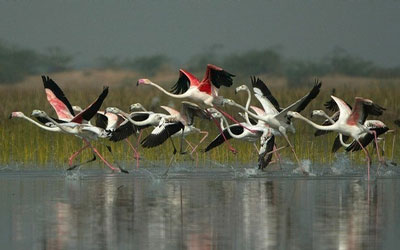 Mumbai:
Mumbai: Two important bird and biodiversity areas in Maharashtra are among 10 across India that are in serious danger of being lost forever due to unsustainable developmental pactices, a new study warned Saturday.
The report, titled 'Important Bird and Biodiversity Areas: A Global Network for Conserving Nature & Benefitting People', was prepared by Bombay Natural History Society (BNHS) in association with Britain's BirdLife International.
A BNHS spokesperson said a component of the study report "IBAs in Danger" lists at least 10 major Indian sites which could be lost forever unless immediate remedial measures are undertaken to protect them.
Some of the sites are Sewri-Mahul Creek, Mumbai and Great Indian Bustard Sanctuary in Solapur/Ahmednagar (both in Maharashtra), Flamingo City in Kutch (Gujarat), Ranebennur in Haveri (Karnataka), Basai in Gurgaon (Haryana), Tillangchong in Andaman and Nicobar Isles and four in Madhya Pradesh, including Sailana Kharmor Sanctuary in Ratlam.
The report has been presented at the ongoing World Parks Congress in Sydney, Australia.
The report said the 10 IBAs are amongst the most threatened bird sanctuaries in the country which cover habitats like coastal and inland wetlands, grasslands and forests which are at greatest risk of losing their key biodiversity.
There are many other IBAs, although not on the current list, which are also under pressures from different types of unsustainable human interference.
Besides attracting and nurturing different types of birds, a majority of these IBAs provide for eco-system services like water supply for drinking and irrigation, tourism potential and natural pest control if they are managed properly.
Highlighting some of the major causes behind the loss of biodiversity and habitat in these IBAs and others, the report has listed destruction or disturbances due to infrastructure developments, wrong anti-people conservation policies and indiscriminate livestock grazing beyond traditional pastoral lands.
The other factors are indiscriminate agricultural expansion and use of pesticides, rapid urbanisation, industrial and sewage pollution and poaching.
"Unfortunately in India, nearly 50 percent of the IBAs do not get any kind of official recognition from the government agencies. These (10) are areas which need utmost and urgent protection if we are really serious about saving India's threatened bird species," said scientist Raju Kasambe, BNHS's IBA Programme Project Manager.
BirdLife International's Director of Science, Policy & Information Melanie Heath said at present, 356 of the 12,000 IBAs spread across 122 countries in the world are in similar danger, though half of them are legally protected.
 Mumbai: Two important bird and biodiversity areas in Maharashtra are among 10 across India that are in serious danger of being lost forever due to unsustainable developmental pactices, a new study warned Saturday.
Mumbai: Two important bird and biodiversity areas in Maharashtra are among 10 across India that are in serious danger of being lost forever due to unsustainable developmental pactices, a new study warned Saturday.